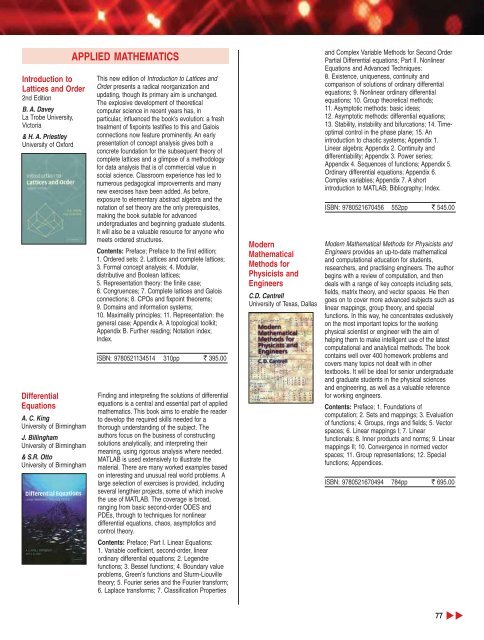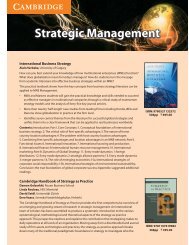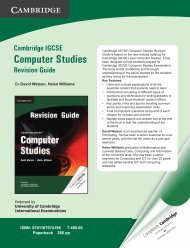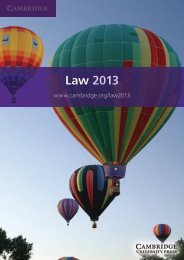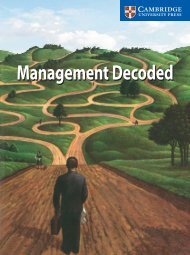ENGINEERING - Cambridge University Press India
ENGINEERING - Cambridge University Press India
ENGINEERING - Cambridge University Press India
Create successful ePaper yourself
Turn your PDF publications into a flip-book with our unique Google optimized e-Paper software.
Introduction to<br />
Lattices and Order<br />
2nd Edition<br />
B. A. Davey<br />
La Trobe <strong>University</strong>,<br />
Victoria<br />
& H. A. Priestley<br />
<strong>University</strong> of Oxford<br />
Differential<br />
Equations<br />
A. C. King<br />
<strong>University</strong> of Birmingham<br />
J. Billingham<br />
<strong>University</strong> of Birmingham<br />
& S.R. Otto<br />
<strong>University</strong> of Birmingham<br />
APPLIED MATHEMATICS<br />
This new edition of Introduction to Lattices and<br />
Order presents a radical reorganization and<br />
updating, though its primary aim is unchanged.<br />
The explosive development of theoretical<br />
computer science in recent years has, in<br />
particular, influenced the book's evolution: a fresh<br />
treatment of fixpoints testifies to this and Galois<br />
connections now feature prominently. An early<br />
presentation of concept analysis gives both a<br />
concrete foundation for the subsequent theory of<br />
complete lattices and a glimpse of a methodology<br />
for data analysis that is of commercial value in<br />
social science. Classroom experience has led to<br />
numerous pedagogical improvements and many<br />
new exercises have been added. As before,<br />
exposure to elementary abstract algebra and the<br />
notation of set theory are the only prerequisites,<br />
making the book suitable for advanced<br />
undergraduates and beginning graduate students.<br />
It will also be a valuable resource for anyone who<br />
meets ordered structures.<br />
Contents: Preface; Preface to the first edition;<br />
1. Ordered sets; 2. Lattices and complete lattices;<br />
3. Formal concept analysis; 4. Modular,<br />
distributive and Boolean lattices;<br />
5. Representation theory: the finite case;<br />
6. Congruences; 7. Complete lattices and Galois<br />
connections; 8. CPOs and fixpoint theorems;<br />
9. Domains and information systems;<br />
10. Maximality principles; 11. Representation: the<br />
general case; Appendix A. A topological toolkit;<br />
Appendix B. Further reading; Notation index;<br />
Index.<br />
ISBN: 9780521134514 310pp ` 395.00<br />
Finding and interpreting the solutions of differential<br />
equations is a central and essential part of applied<br />
mathematics. This book aims to enable the reader<br />
to develop the required skills needed for a<br />
thorough understanding of the subject. The<br />
authors focus on the business of constructing<br />
solutions analytically, and interpreting their<br />
meaning, using rigorous analysis where needed.<br />
MATLAB is used extensively to illustrate the<br />
material. There are many worked examples based<br />
on interesting and unusual real world problems. A<br />
large selection of exercises is provided, including<br />
several lengthier projects, some of which involve<br />
the use of MATLAB. The coverage is broad,<br />
ranging from basic second-order ODES and<br />
PDEs, through to techniques for nonlinear<br />
differential equations, chaos, asymptotics and<br />
control theory.<br />
Contents: Preface; Part I. Linear Equations:<br />
1. Variable coefficient, second-order, linear<br />
ordinary differential equations; 2. Legendre<br />
functions; 3. Bessel functions; 4. Boundary value<br />
problems, Green’s functions and Sturm-Liouville<br />
theory; 5. Fourier series and the Fourier transform;<br />
6. Laplace transforms; 7. Classification Properties<br />
Modern<br />
Mathematical<br />
Methods for<br />
Physicists and<br />
Engineers<br />
C.D. Cantrell<br />
<strong>University</strong> of Texas, Dallas<br />
and Complex Variable Methods for Second Order<br />
Partial Differential equations; Part II. Nonlinear<br />
Equations and Advanced Techniques:<br />
8. Existence, uniqueness, continuity and<br />
comparison of solutions of ordinary differential<br />
equations; 9. Nonlinear ordinary differential<br />
equations; 10. Group theoretical methods;<br />
11. Asymptotic methods: basic ideas;<br />
12. Asymptotic methods: differential equations;<br />
13. Stability, instability and bifurcations; 14. Timeoptimal<br />
control in the phase plane; 15. An<br />
introduction to chaotic systems; Appendix 1.<br />
Linear algebra; Appendix 2. Continuity and<br />
differentiability; Appendix 3. Power series;<br />
Appendix 4. Sequences of functions; Appendix 5.<br />
Ordinary differential equations; Appendix 6.<br />
Complex variables; Appendix 7. A short<br />
introduction to MATLAB; Bibliography; Index.<br />
ISBN: 9780521670456 552pp ` 545.00<br />
Modern Mathematical Methods for Physicists and<br />
Engineers provides an up-to-date mathematical<br />
and computational education for students,<br />
researchers, and practising engineers. The author<br />
begins with a review of computation, and then<br />
deals with a range of key concepts including sets,<br />
fields, matrix theory, and vector spaces. He then<br />
goes on to cover more advanced subjects such as<br />
linear mappings, group theory, and special<br />
functions. In this way, he concentrates exclusively<br />
on the most important topics for the working<br />
physical scientist or engineer with the aim of<br />
helping them to make intelligent use of the latest<br />
computational and analytical methods. The book<br />
contains well over 400 homework problems and<br />
covers many topics not dealt with in other<br />
textbooks. It will be ideal for senior undergraduate<br />
and graduate students in the physical sciences<br />
and engineering, as well as a valuable reference<br />
for working engineers.<br />
Contents: Preface; 1. Foundations of<br />
computation; 2. Sets and mappings; 3. Evaluation<br />
of functions; 4. Groups, rings and fields; 5. Vector<br />
spaces; 6. Linear mappings I; 7. Linear<br />
functionals; 8. Inner products and norms; 9. Linear<br />
mappings II; 10. Convergence in normed vector<br />
spaces; 11. Group representations; 12. Special<br />
functions; Appendices.<br />
ISBN: 9780521670494 784pp ` 695.00<br />
77


